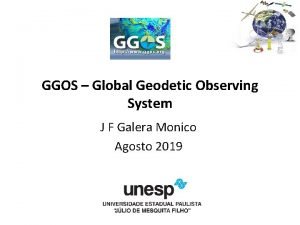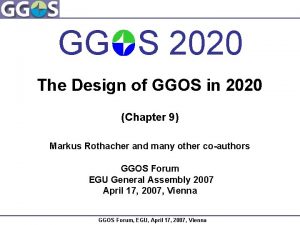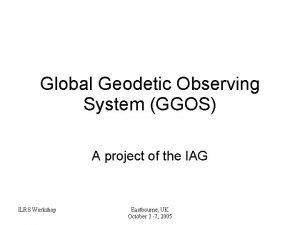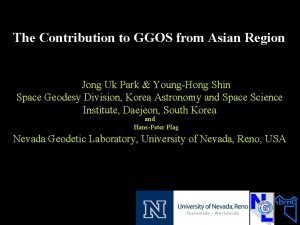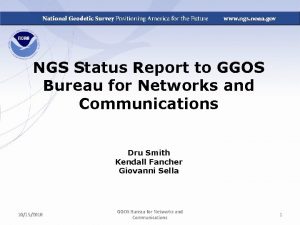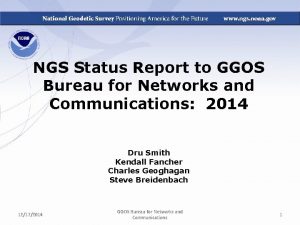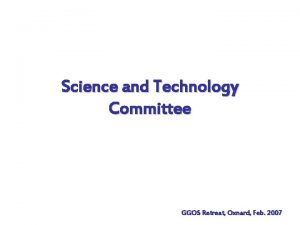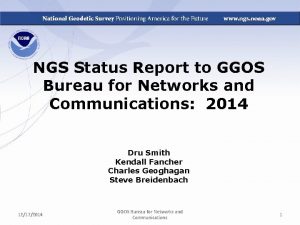GG S 2020 The Design of GGOS in










- Slides: 10

GG S 2020 The Design of GGOS in 2020 (Chapter 9) Markus Rothacher and many other co-authors GGOS Forum EGU General Assembly 2007 April 17, 2007, Vienna GGOS Forum, EGU, April 17, 2007, Vienna

Measuring and Modeling the Earth‘s System Measuring Information about Earth System Geometry Space Geodetic Techniques VLBI SLR/LLR GNSS DORIS Altimetry In. SAR Gravity Missions Earth System Station Position/Motion, Sea Level Change, Deformation C O M B I N A T Terrestrial I Techniques O Levelling N Abs. /Rel. Sun/Moon I (Planets) N T Atmosphere E Ocean R Hydrosphere A C Cryosphere T I Core O Mantle N Crust S Earth Rotation Precession/Nutation, Polar Motion, UT 1, LOD Gravity Geocenter Gravity field, Temporal variations Gravimetry Tide Gauges Air-/Shipborne Observation Modelling Influence / Modelling GGOS Forum, EGU, April 17, 2007, Vienna

Structure of GGOS 2020 (Technical Part) Coordination through IAG Services Global Networks of Observing Stations Analysis, Combination, Modeling Coordination Center(s) Regional and Global Data and Product Centers Archiving and Dissemination Earth Observation Satellites / Planetary Missions GGOS Portal Combination Centers Missionspecific Data and Product Centers Archiving and Dissemination Satellite/Planetary Mission Coordination Centers (IAG Services) Quality Assurance Data Analysis Centers Access to all information, data, products Modeling Centers Users Science & Society Meta data; information GGOS Forum, EGU, April 17, 2007, Vienna Real data; information

Integration of 5 Levels into a GGOS 5 Level 4 Moon, Planets Moon GGOS Forum, EGU, April 17, 2007, Vienna

Ground-Based Infrastructure Individual Networks: • Station networks of VLBI, SLR/LLR, GNSS, DORIS • Permanent absolute and superconducting gravimeters; tide gauges • Air-borne, ship-borne data aquisition • RT data transfer; new communication technologies for remote areas ~30 -40 Fundamental Stations: • Co-location of several techniques; 1 mm local tie measured, additional sensors (meteo, WVR, ultra-stable oscillators, gravimeters, seismometer, tiltmeters, …), highly automated, 24 hours a day / 7 days a week • Latest technologies: – – – GNSS: all GNSS, 50 Hz real-time data, 3 receivers/antennas, … SLR: k. Hz, fast telescopes, two colors, transponders on Moon/planets VLBI: continuous obs. , new/multiple telescopes, real-time, obs. of (GNSS) satellites, space VLBI, … Densification with GNSS stations: ~ 1000 GNSS stations, stable monuments GGOS Forum, EGU, April 17, 2007, Vienna

LEOs Missions Relevant to GGOS Already existing missions and funded future missions: Mission Type Mission Duration CHAMP Gravity/ magnetic field/ atmosphere 2000 – 2009 GRACE Gravity, atmosphere 2002 – 2010 GOCE Gravity (stationary, high-resolution) 2007 – 2009 TOPEX-POSEIDON Ocean altimetry 1992 – 2004 Jason-1 Ocean altimetry 2001 – 2007 ICESAT Ice altimetry 2003 – 2008 CRYOSAT-2 Ice altimetry 2009 – 2011 ERS-2 Altimetry/ climate/ environment 1995 – 2008 ENVISAT Altimetry/ climate/ environment 2002 – 2008 Terra. SAR-X SAR/ In. SAR/ atmosphere 2007 – 2010 Tan. DEM-X SAR/ In. SAR/ atmosphere 2009 – 2011 En. MAP Optical / hyperspectral 2010 – 2013 SWARM Magnetic field 2009 – 2014 GGOS Forum, EGU, April 17, 2007, Vienna

LEO Satellite Missions: • Continuous observations over decades, long time series (trends) • Chains of satellite missions (altimetry, gravity, In. SAR, …) • Constellations of satellites (COSMIC, SWARM, …), micro- and nano-satellites • Formation flying: several satellites forming “one large instrument” • Near real-time data transfer (inter-satellite comm. ) and analysis (early warning systems) • • Development of new sensors and technologies (e. g. , GNSS reflectometry and scatterometry, laser interferometry between satellites, ultra-stable oscillators in space) Satellites allowing co-location of space geodetic techniques (GNSS receiver , SLR retroreflector, VLBI emitter, gradiometer; SLR on GNSS satellites, VLBI in space, transponders on planets, …) GGOS Forum, EGU, April 17, 2007, Vienna

Processing, Analysis, Combination Processing and Analysis: • • Fully automated processing in near real-time or even in real-time (early warning systems, GNSS seismology, atmosphere sounding, …) Full reprocessing capabilities for all data available, long consistent time series for long-term trends Combination of all data types on the observation level Combination with LEO data (co-location, gravity, geocenter, atmosphere, …) Combination with satellite altimetry data (and with In. SAR ? ) Combination with terrestrial data (e. g. gravity field, …) Combination of different analysis centers (redundancy, reliability, accuracy, …) Improvements in modeling, parameterization, conventions Supercomputers, visualization GGOS Forum, EGU, April 17, 2007, Vienna

GGOS: Future Combination Space Parameter space for a rigorous combination: Parameter Type VLBI X X Atmosphere X X (X) X X X X X (X) X X X (X) GGOS Forum, EGU, April 17, 2007, Vienna (X) X Altimetry (X) X X X Gravity Field ITRF X (X) X LLR Earth Rotation ICRF Quasar. Coord. (ICRF) Nutation Polar Motion UT 1 Length of Day (LOD) Coord. +Veloc. (ITRF) Geocenter Gravity Field Orbits LEO Orbits Ionosphere Troposphere Time/Freq. ; Clocks GPS/ DORIS/ SLR GLON. PRARE

4 D Models of the Earth System Interactions modified from H. Schuh Lunisolar Gravitational acceleration Oceanic tides Atmospheric tides Angular torques Density variations in the atmosphere Atmospheric loading Angular momentum variation of the atmosphere Effects from Earth interior Tides of the solid Earth Ocean currents Global ground water Snow Ocean loading Angular momentum variation of the oceans Deformation of the Earth Precession, Nutation Polar motion Length of day Postglacial land uplift … Tectonic plate motion Volcanism Earthquakes Pole tides Orientation of the Earth Global vegetation Gravity Field of the Earth GGOS Forum, EGU, April 17, 2007, Vienna
